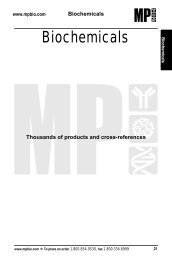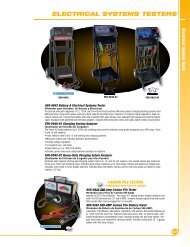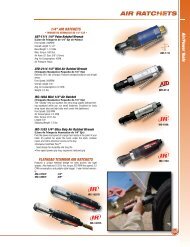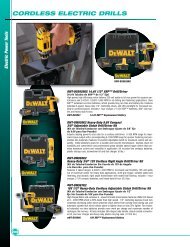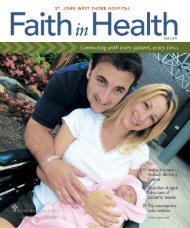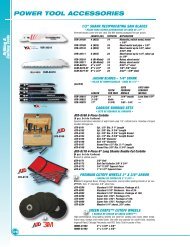INSIDE
INSIDE
INSIDE
You also want an ePaper? Increase the reach of your titles
YUMPU automatically turns print PDFs into web optimized ePapers that Google loves.
inside<br />
02 Navigating Benefits<br />
04 Step 1: Set Limits<br />
06 Step 2: Shop Smart<br />
07 Step 3: Kick the Tires<br />
08 Step 4: Consider Alternative Routes<br />
10 Health Plan Comparison Chart<br />
12 Step 5: Drive Communications<br />
14 Step 6: Put Wellness to Work<br />
17 Step 7: Ask for Medicare Directions<br />
20 Road Side Assistance<br />
1 • COSE Update Special Insert • June 2009 (216) 592-2222
Navigating the Winding<br />
Road of Benefits<br />
You’re in the driver’s seat. So here are directions to finding affordable benefits<br />
solutions designed specifically for small businesses.<br />
It’s an employee retention tool, a morale booster and a productivity driver.<br />
Families depend on it—and so do you, the business owner. Health benefits are<br />
a critical part of overall compensation because they protect the bottom line by<br />
“insuring” a company’s greatest asset. People.<br />
Also, benefits and wellness are an investment business owners take seriously<br />
because the stakes are so high. Compromising on health insurance can<br />
inadvertently affect the bottom line. We know that employees who stay well<br />
perform better in the workplace. “An effective benefits plan will not only keep<br />
employees healthy, it will prevent absenteeism, tardiness and turnover,” says<br />
Patty Starr, senior director of health insurance and benefits, COSE.<br />
No business can afford to give benefits less than 100 percent attention.<br />
“In order to retain employees, you have to offer solid benefits,” says Lisa<br />
Logan, executive vice president, Logan Clutch Corp., Cleveland. “When you look<br />
at how layoffs and pay cuts affect the workforce, you don’t want to cut benefits<br />
because that really affects families.”<br />
COSE learned from its 2009 Employer Benefits Survey that more than half<br />
of small business respondents echo Logan’s sentiments. Despite a challenging<br />
economy, 56 percent of Northeast Ohio employers with health insurance cover at<br />
least 80 percent of premium costs for employees. Thirty-eight percent cover 100<br />
percent of premium costs. And only 13 percent reported some decrease in health<br />
insurance coverage due to economic factors.<br />
But according to the 2008 Kaiser Family Foundation Employer Health<br />
Benefits study, large percentages of firms are likely to make changes by increasing<br />
the amount workers contribute to<br />
premiums (40%), increasing deductible<br />
amounts (41%), increasing office visit<br />
cost sharing (45%), or increasing<br />
the amount that employees pay for<br />
prescriptions drugs (41%).<br />
Now, more than ever, small<br />
employers have to take a close look at<br />
how their managing their benefits.<br />
And as employers work to provide<br />
affordable, quality health insurance to<br />
employees, they are also recognizing<br />
that they must educate their workers.<br />
Because the fact is, employers are<br />
much more than the purchaser and<br />
distributor of plans that bundle medical<br />
and wellness solutions, prescription<br />
coverage, vision and dental. They<br />
are also the primary “instructor”<br />
explaining to employees the value and<br />
opportunities benefits offer.<br />
“The business owner is a provider<br />
of information,” Starr explains. “Since<br />
Ask for Directions<br />
Whether you’re considering COSE membership, or<br />
weighing the opportunities of benefits renewal, this is your<br />
chance to get the maximum return on your benefits investment.<br />
For more than 35 years, COSE has provided health benefits<br />
designed exclusively for Northeast Ohio small businesses. We<br />
research, we listen, and we work hard everyday to provide the<br />
best benefit opportunities to Northeast Ohio small employers.<br />
Renewal time is your chance to offer some new options that<br />
could help save money without compromising quality care.<br />
Also consider making your benefits package more attractive<br />
by adding vision, dental and life insurance without adding<br />
significant cost.<br />
But we also go a step further for members than the average<br />
provider. We’ve designed a proven benefits selection process<br />
that includes useful tools and resources that can guide you<br />
toward the best options for your company, including:<br />
Benefits Review Sessions are free, 45-minute, one-onone<br />
sessions with COSE benefits experts that can help you fully<br />
2 • COSE Update Special Insert • June 2009 (216) 592-2222
Survey<br />
benefits are such a large investment, it’s important for<br />
employers to take on the role of educator to help employees<br />
make responsible choices concerning their health and<br />
utilization of the company benefits plan.”<br />
If business owners are the instructors, then COSE is the<br />
experienced curriculum provider.<br />
Staffed with seasoned experts who are accessible for<br />
one-on-one Benefits Review Sessions (visit cose.org/brs for<br />
dates and locations), COSE provides employers with the<br />
tools necessary to make the best benefits decisions for the<br />
company, and to educate employees so they can take full<br />
advantage of company-sponsored plans.<br />
“We know it’s not easy to navigate the world of benefits,<br />
so we actively engage employers in Benefits Review Sessions<br />
and help them customize a plan,” says Starr. “We are here to<br />
help them cut through the red tape and really understand<br />
what their plans offer and what changes they could make to<br />
get the best value and create a quality product.”<br />
The initial selection of plans and the renewal process<br />
does involve some analysis, but we’re here to help with<br />
our seven step process to finding a benefits solution. Sit<br />
down with a COSE expert during one of our scheduled<br />
Benefits Review Sessions or don’t hesitate to call our<br />
Customer Service representatives as you work through all<br />
your options.<br />
The energy you invest in finding the best solution will<br />
pay off for your business.<br />
Have economic conditions changed<br />
employee health insurance coverage?<br />
No change 49%<br />
Asking employees to share more costs 12%<br />
Considering decreasing or discontinuing coverage 11%<br />
Some decreases in coverage 11%<br />
No longer offering coverage 2%<br />
Source: 2009 COSE Employer Benefits Survey<br />
Nationally, businesses are considering changes.<br />
Office visit cost sharing 45%<br />
Deductible amounts 41%<br />
Prescriptions drugs 41%<br />
Amount employees contribute to premiums 40%<br />
Source: 2008 Kaiser Family Foundation Employer Health Benefits study.<br />
Since “ benefits are such a large<br />
investment, it’s important for<br />
employers to take on the role of<br />
educator to help employees make<br />
responsible choices concerning<br />
their health and utilization of the<br />
company benefits plan.”<br />
–Patty Starr, COSE<br />
understand your benefits options and customize those options<br />
to meet the needs of your employees and your bottom line.<br />
Renewal packets are mailed prior to your benefits renewal<br />
period and contain everything necessary to review and make<br />
changes to your current benefits design.<br />
Customer Service Representatives are available<br />
during regular business hours to help you determine the right<br />
mix of benefits for your small business.<br />
(216) 592-2222 or customerservice@cose.org<br />
cose.org/benefits
Set Limits<br />
How much of your budget can you reserve for benefits? The answer to this<br />
question is different for every company, and there is not a one-size-fits-all<br />
solution in the benefits arena. That’s why COSE offers more than 35 base<br />
plans and, ultimately, more than 120 different plan designs.<br />
To determine what type of plan(s) is the best fit for your organization, first<br />
establish an annual benefits limit, which is a fixed amount or percentage of<br />
monthly income that you are willing to contribute to each employee’s benefits plan.<br />
Evaluate employee turnover and realistically consider how you compensate<br />
employees for their hard work. Are you giving back to your staff by providing<br />
them with the benefits they need to maintain a healthy and productive life?<br />
“Evaluate employee wants<br />
and needs so you can<br />
determine whether<br />
you’re offering plan<br />
designs that match your<br />
employee population.”<br />
–Patty Starr, COSE<br />
Benefits Checklist<br />
Establish an annual benefits limit. A fixed amount that an<br />
employer is willing to contribute for each employee’s benefits plan.<br />
Evaluate staff turnover and realistically look at how<br />
you’re paying employees for their services compared to their<br />
benefits structure.<br />
Review what plan characteristics are most important<br />
to your employees. Gather the information through informal<br />
and confidential surveys.<br />
Consider offering a base plan with buy-up, buydown<br />
options. Remember, COSE allows you to offer up to<br />
two different plans plus a Health Savings Account (HSA) or<br />
Health Reimbursement Arrangement (HRA) for a total of three<br />
plan offerings.<br />
Compare apples-to-apples. If you shop around for<br />
benefits, look at the same deductibles, out-of-pocket costs,<br />
copays and prescription drug benefits, and whether there are<br />
monthly administrative fees. Although we believe that COSE is<br />
4 • COSE Update Special Insert • June 2009 (216) 592-2222
Although we believe that<br />
COSE is offering you the best<br />
price, let us know if you find<br />
one that is better. We can<br />
work with the carrier to<br />
better your rate.<br />
What is important to your employees and how do they<br />
really use their benefits? “Evaluate employee wants and<br />
needs so you can determine whether you’re offering plan<br />
designs that match your employee population,” Starr says<br />
Kelly Frye, president of Ten 29 Design in Ohio City, went<br />
through this exercise during a COSE Benefits Review Session<br />
and learned that he could be saving a couple hundred dollars<br />
each month by changing his benefits plan design.<br />
By listing his wife, co-conspirator in the business, as a<br />
dependent rather than an employee, Frye and his family get<br />
the same quality coverage at a lower cost.<br />
“We were educated more during the 45-minute Review<br />
Session than we have ever been,” Frye says. “We are a<br />
healthy family, so we were concerned that we were<br />
spending too much and we wanted to cut costs. We were<br />
able to accomplish that.”<br />
As you review how you and employees use benefits, take<br />
this opportunity to educate your workforce on the true cost<br />
of health insurance. Show them how smart choices<br />
concerning plan utilization can make a difference in your<br />
company’s total cost.<br />
Starr recommends distributing a compensation<br />
breakdown that shows how much an employee truly gets<br />
paid in terms of salary and benefits at least annually.<br />
“Benefits can make up a significant portion of overall<br />
compensation,” she says.<br />
Recently, the Zaremba Group in Lakewood conducted a<br />
staff survey asking employees to estimate benefits costs.<br />
After reviewing the responses, Zaremba crafted a<br />
communication plan to help employees better understand<br />
the true cost of their benefits package.<br />
offering you the best price, let us know if you find one that is<br />
better. We can work with the carrier to better your rate.<br />
Review what’s out there and determine if your benefits<br />
package is competitive in your industry and in the overall<br />
regional marketplace.<br />
Communicate with employees, not only annually about<br />
benefits coverage, but quarterly to help them better understand<br />
their health care options and the costs associated with these<br />
benefits. Also encourage employees to use wellness or<br />
preventive measures available through their health insurance<br />
plan and the COSE Wellness Program. Such efforts can pay big<br />
dividends for workers and for you in terms of improved health,<br />
increased productivity and lower-long-term health care costs.<br />
Think about compensating employees who opt out of<br />
benefits if they can receive them through another plan.<br />
(216) 592-2222 or customerservice@cose.org<br />
cose.org/benefits June 2009 • COSE Update Special Insert • 5
Shop Smart<br />
Health insurance<br />
and wellness<br />
offerings are an<br />
important factor in<br />
employee attraction<br />
and retention.<br />
What type of benefits do other<br />
companies in the region<br />
offer employees?<br />
Compare your benefits plan with<br />
other businesses in your industry.<br />
Also consult with a COSE<br />
representative to find out what other<br />
members provide workers.<br />
Remember, health insurance and<br />
wellness offerings are an important<br />
factor in employee attraction and<br />
retention, so be sure your plan is<br />
relevant and highly valued.<br />
Curious to know what benefits<br />
other companies in this area offer<br />
their employees?<br />
Ask. Talk with other small business<br />
owners at networking events or<br />
health insurance presentations. Or<br />
consider asking competitors and your<br />
accountant for insight while making a<br />
benefits decision.<br />
And most importantly, ask your<br />
employees. They may have knowledge<br />
of what other companies are offering,<br />
and they will definitely provide<br />
feedback on what they prefer in a<br />
health plan—but only if you ask.<br />
Case in point: By adding vision<br />
coverage, Precision Fittings took into<br />
consideration its employees needs.<br />
Precision Fittings employees may<br />
need to wear safety glasses, depending<br />
on an employees’ position. The<br />
company’s benefits plan includes free<br />
eye exams and complete coverage for<br />
safety glasses. Employees who require<br />
prescription glasses get a discount,<br />
explains Renee Pavelko, payroll and<br />
benefits administrator at Precision<br />
Fittings in Wellington.<br />
Lisa Logan, executive vice<br />
president of Logan Clutch Corp.<br />
in Cleveland is careful to consult<br />
with employees every year prior to<br />
benefits renewal. “Since we have a<br />
family-owned business, we are all<br />
working toward the common goal<br />
to get the best product for the<br />
best price,” she says. “We are all in<br />
this together.”<br />
Keep in mind, through COSE you<br />
can offer up to three different plans<br />
including an HSA or HRA option.<br />
Consider the value of offering a base<br />
plan with an employee buy-up to<br />
richer benefits.<br />
6 • COSE Update Special Insert • June 2009 (216) 592-2222
Kick the Tires<br />
With more than 120 benefit<br />
plans configurations available<br />
to COSE members, how do<br />
you compare the plan you have with<br />
others you’re considering? To get the<br />
real story on value and cost, you must<br />
compare apples-to-apples.<br />
If you shop for health care benefits,<br />
at the very least make a list of these<br />
key comparables:<br />
• deductibles<br />
• co-insurance<br />
• copays<br />
• out-of-pocket maximum<br />
• lifetime/annual maximum<br />
• prescription drug benefits<br />
• administrative costs<br />
The area that business owners are<br />
most likely to overlook during a plan<br />
comparison is out-of-pocket<br />
maximums, says Patty Starr, senior<br />
director of health insurance and<br />
benefits for COSE. “You will find a<br />
large variation there, and some really<br />
big surprises,” she says.<br />
Consider this example. You get a<br />
medical procedure with a $10,000<br />
ticket price. Your insurance<br />
deductible is $500. That brings the<br />
invoice down to $9,500. But with an<br />
80/20 plan and an out-of-pocket of<br />
$1,250, you must pay 20 percent of the<br />
cost until your 20 percent reaches<br />
$1,250. So the out-of-pocket expense—<br />
including the deductible—is $1,750. In<br />
this scenario, you will meet your<br />
deductible and out-of-pocket expense<br />
with this single claim.<br />
To get the real story on value and cost, you<br />
must compare apples-to-apples.<br />
But using the same scenario,<br />
compare this out-of-pocket cost under<br />
a different plan that requires paying 50<br />
percent of the cost with an out-ofpacket<br />
of $3,000. Now your total<br />
medical expenditure is $3,500. Here<br />
you will not meet your out-of-pocket<br />
limit, so additional claims during the<br />
benefit period may require 50 percent<br />
payment until you reach your out-ofpocket<br />
limit. Bottom line, this option is<br />
more expensive for employees.<br />
A COSE Benefits Review Session is<br />
an ideal opportunity to hash through<br />
all these details. Judy Seidel, an<br />
independent travel consultant and<br />
owner of Judith A. Seidel, CTC, LLC,<br />
decided four years ago to get a Health<br />
Savings Account (HSA). “I realized<br />
that it would be more beneficial to<br />
decrease my monthly premium and<br />
have the savings for a really big event<br />
rather than paying a higher premium<br />
every month,” she says.<br />
Aside from comparing all of the<br />
numbers, consider the wellness benefits<br />
a plan may provide. “We believe that<br />
wellness program participation will<br />
help avoid costly health issues in the<br />
future,” Seidel says.<br />
What percentage of<br />
premium costs do you<br />
cover for employees?<br />
100 percent coverage 39%<br />
80 percent coverage 19%<br />
50 percent coverage 12%<br />
Less than 50 percent 8%<br />
Source: 2009 COSE Employer Benefits Survey<br />
cose.org/benefits<br />
June 2009 • COSE Update Special Insert • 7
Consider Alternative<br />
Routes<br />
More business owners today are<br />
turning to Health Savings<br />
Accounts (HSAs) to provide<br />
employees with flexibility and control<br />
over their coverage. In fact, 35 percent<br />
of COSE survey respondents reported<br />
offering an alternative health care funding<br />
option, such as an HSA, Health<br />
Reimbursement Arrangement (HRA)<br />
or Flexible Spending Account (FSA).<br />
That’s up from 20 percent from 2008.<br />
Logan Clutch Corp. began offering<br />
HSAs to employees in January. Currently,<br />
the company owners and product line<br />
managers are taking advantage of the<br />
alternative funding solution. Lisa Logan,<br />
executive vice president, says managers<br />
Think of these plans as bank<br />
accounts that provide<br />
employees with unprecedented<br />
control over their earned<br />
health care dollars.<br />
will use their experience to educate<br />
other employees about the plan.<br />
“If we can give our staff a personal<br />
testimony and say, ‘We tried it. It’s O.K.<br />
Here is how it works,’ they might feel<br />
more secure,” Logan says.<br />
While there is some confusion<br />
concerning how these “alternatives”<br />
work, businesses are embracing these<br />
plans because they can give employees<br />
the perk of an insurance fund that is<br />
flexible, portable (they can take it with<br />
them if they switch employers), and<br />
capable of providing tax advantages.<br />
Still not sure how this could work<br />
for your company? Think of these<br />
plans as bank accounts that provide<br />
employees with unprecedented<br />
control over their earned health<br />
care dollars. They can spend it, or<br />
they can save it—but most important,<br />
employees will soon realize the<br />
true cost of health care and it<br />
won’t take long until they are more<br />
informed consumers.<br />
*COSE strongly encourages participants to<br />
consult with both their accountant and attorney<br />
to discover the best option for their business.<br />
Health Savings Account (HSA) Combines a qualified<br />
high-deductible health plan with a tax-advantaged savings<br />
account, allowing employees to save and pay for routine<br />
medical expenses with pre-tax dollars. Employees own their<br />
account and unused dollars roll over year after year.<br />
Who qualifies? Any individual covered by a qualified high<br />
deductible health plan (HDHP) who is not covered by other<br />
health insurance, Medicare, or is claimed as a dependent.<br />
Health Reimbursement Arrangement (HRA)<br />
An employer funded account that provides reimbursement<br />
for specific employee and dependent medical expenses.<br />
Employees lose unused dollars when they switch employers.<br />
Who qualifies? Any employee that meets an employer’s health<br />
benefits eligibility criteria and are not enrolled in an HSA.<br />
Flexible Spending Account (FSA) Section 125 plans<br />
(the name refers to the section of the Internal Revenue Code)<br />
are also called flexible benefits plans or Flexible Spending<br />
Accounts (FSAs). These plans allow employees to save by<br />
paying for health insurance premiums, out-of-pocket medical<br />
expenses, and child-dependent care expenses with pre-tax<br />
dollars. The company saves by paying lower matching Social<br />
Security and Medicare contributions. However, all dollars<br />
placed in the account will be compromised if not spent by the<br />
end of each year.<br />
Who qualifies? Same as an HRA; however self-employed<br />
individuals are not eligible.<br />
8 • COSE Update Special Insert • June 2009 (216) 592-2222
Compare Alternative Funding Solutions for Yourself<br />
Health Savings Account (HSA) Health Reimbursement Arrangement (HRA) Flexible Spending Account (FSA)<br />
Enacting Law/IRS Code Enacting Law: Medicare Modernization Act of 2003 IRS Code: Section 105 IRS Code: Section 125<br />
Who Owns the<br />
Account?<br />
Eligible employee Employer Eligible Employee<br />
Who Funds the<br />
Account?<br />
Eligible employee, employer and/or other individuals<br />
on behalf of eligible employee<br />
Employer<br />
Eligible employee or employers<br />
How is the Account<br />
Funded?<br />
Deposited directly into account<br />
“Zero-balance account.” This is not a true account<br />
but an agreement or “IOU” by an employer<br />
to pay a portion of qualified medical expenses.<br />
Via payroll deduction; claims are<br />
generally paid as they are submitted<br />
by employee.<br />
Is There A Maximum<br />
Contribution<br />
Per Year?<br />
Individual limit increases from $3,000 in 2009 to<br />
$3,050 in 2010. Family limit increases from $5,950 in<br />
2009 to $6,150 in 2010.<br />
No statutory limit. Simply an arrangement where<br />
employer pays medical expenses.<br />
No statutory limit. Employers<br />
generally set annual plan limit.<br />
Is It A Personal<br />
Account?<br />
Does It Accrue<br />
Interest?<br />
Yes Yes Yes<br />
Yes, tax free No No<br />
What Type Of Health<br />
Plan Is Required,<br />
If Any?<br />
The minimum deductible for individual is $1,150 in 2009<br />
and $1,200 in 2010. The minimum for family coverage<br />
is $2,300 in 2009 and $2,400 in 2010. The maximum<br />
annual out-of-pocket amount for individual coverage is<br />
$5,800 in 2009 and $5,950 in 2010 and family coverage<br />
is $11,600 in 2009 and $11,900 in 2010.<br />
No requirements<br />
No requirements<br />
Can Funds Be Used<br />
To Pay For Non-Qualified<br />
Expenses?<br />
No. Funds used for non-medical expenses are taxed<br />
and/or penalized<br />
—Qualified expenses include more than medical.<br />
Funds may not be used for non-qualified<br />
medical expenses.<br />
No. Funds used for non-medical expenses<br />
are taxed and/or penalized.<br />
What Is The Tax<br />
Treatment?<br />
Contributions are 100% tax deductible. Funds spent<br />
on medical expenses are tax free for life. At 65,<br />
funds used to supplement income are tax-deferred.<br />
Funds used to pay for health expenses are not<br />
reported as income.<br />
Contributions are 100% tax<br />
deductible; funds spent on health<br />
expenses are tax-free (no rollover).<br />
Is There A “Catch Up”<br />
Provision?<br />
$1,000 can be contributed and rollovers will be<br />
permitted.<br />
No<br />
No<br />
Advantages<br />
• Affordability—lower health insurance premiums<br />
• Raises employee awareness of the costs of health<br />
care services<br />
• Tax advantages for employer and employees;<br />
account dollars and interest are 100% tax-free<br />
when used for eligible medical expenses<br />
• Portable—employees own the account<br />
• Savings/Growth Opportunity—gives employees<br />
their own account to pay for long-term health care<br />
costs, grows over time<br />
• Reduced insurance premiums to help stabilize<br />
annual increases<br />
• Gradually raises employee awareness of the<br />
cost of health care services<br />
• Tax-advantaged employer-funded accounts help<br />
pay for day-to-day expenses<br />
• Allows ‘employer pay first’ or ‘employee pay<br />
first’ plan designs<br />
• Competitive administration rates<br />
• Reduces taxable payroll by<br />
reducing your employees’ taxable<br />
income and reduced employer<br />
payroll taxes<br />
• Employees increase take-home pay<br />
• Start a Premium Only Plan (POP)<br />
at any time during the year<br />
•First-year tax savings are generally<br />
greater than the cost of plan<br />
implementation<br />
• Competitive administration rates<br />
COSE Offerings<br />
Six Plan Choices:<br />
• COSE HSA SuperMed Plus 1500<br />
• COSE SuperMed Plus 2000/4000<br />
• COSE HSA SuperMed Plus 2500/100<br />
• COSE HSA SuperMed Plus 3000/100<br />
• COSE HSA SuperMed Plus 4000/100<br />
• COSE HSA SuperMed Plus 5000/100<br />
—All have 100% preventive care coverage, not<br />
subject to deductible. All utilize the SuperMed Plus<br />
network of providers.<br />
• COSE HRA SuperMed Plus 1000/3000<br />
• COSE HRA SuperMed Plus 2000/6000<br />
• COSE HRA SuperMed Plus 2500/5000<br />
• COSE HRA SuperMed Plus 3000/9000<br />
—All have 100% preventive care coverage, not<br />
subject to deductible. All utilize the SuperMed<br />
Plus network of providers.<br />
• Premium Only Plan (POP)<br />
• Flexible Spending Accounts<br />
• Daycare (Child and Elder) Accounts<br />
• Adoption Assistance Accounts<br />
• Commuter Benefits Accounts<br />
COSE Services<br />
Provided By:<br />
HSA compatible insurance plans offered through<br />
Medical Mutual of Ohio; HSA accounts held by<br />
financial institution of employee’s choice<br />
Medical Mutual of Ohio<br />
FlexSave provide by<br />
Medical Mutual of Ohio<br />
The information presented is related to the 2009-2010 calendar year.<br />
cose.org/benefits<br />
June 2009 • COSE Update Special Insert • 9
Health Plan Comparison Chart<br />
Medical mutual of ohio (MMO) Plans — COSE groups can simultaneously offer any two standard plans and one Health Savings Account (HSA) or Health Reimbur<br />
Annual<br />
Deductible<br />
Coinsurance<br />
Out-of-Pocket<br />
Maximum<br />
(excluding<br />
deductible)<br />
Office Visits<br />
250/500<br />
**supermed<br />
plus<br />
*Supermed<br />
classic Gold<br />
Network:<br />
$250 single<br />
$500 family<br />
Non-Network:<br />
$250 single<br />
$500 family<br />
500/1000<br />
**supermed<br />
plus<br />
*Supermed<br />
classic Gold<br />
Network:<br />
$500 single<br />
$1,000 family<br />
Non-Network:<br />
$500 single<br />
$1,000 family<br />
Plus: Network: 80% Non-Network: 64%<br />
Classic Gold: Network: 90% Non-Network: 80%<br />
Plus:<br />
Network: $1,250 single;<br />
$2,500 family<br />
Non-Network:<br />
$2,500 single; $5,000 family<br />
Classic Gold:<br />
$1,250 single; $2,500 family<br />
750/1500<br />
**supermed<br />
plus<br />
*Supermed<br />
classic Gold<br />
Network:<br />
$750 single<br />
$1,500 family<br />
Non-Network:<br />
$750 single<br />
$1,500 family<br />
1000/2000<br />
**supermed<br />
plus<br />
*Supermed<br />
classic Gold<br />
Network:<br />
$1,000 single<br />
$2,000 family<br />
Non-Network:<br />
$1,000 single<br />
$2,000 family<br />
Plus:<br />
Network: $1,500 single;<br />
$3,000 family<br />
Non-Network:<br />
$2,500 single; $5,000 family<br />
Classic Gold:<br />
$1,500 single; $3,000 family<br />
Supermed plus<br />
2080 - 250<br />
Network:<br />
$250 single<br />
$500 family<br />
Non-Network:<br />
$500 single<br />
$1,000 family<br />
Network: 80%<br />
Non-network:<br />
60% for most services<br />
Network:<br />
$2,000 single<br />
$4,000 family<br />
Non-Network:<br />
$4,000 single<br />
$8,000 family<br />
Supermed plus<br />
2080 - 500<br />
Network:<br />
$500 single<br />
$1,000 family<br />
Non-Network:<br />
$1,000 single<br />
$2,000 family<br />
Network:<br />
$2,500 single<br />
$5,000 family<br />
Non-Network:<br />
$5,000 single<br />
$10,000 family<br />
SUPERMED PLUS<br />
2080 - 750<br />
Network:<br />
$750 single<br />
$1,500 family<br />
Non-Network:<br />
$1,500 single<br />
$3,000 family<br />
Network: 80%<br />
Non-network: 60%<br />
Network:<br />
$2,500 single<br />
$5,000 family<br />
Non-network:<br />
$5,000<br />
$10,000<br />
$15 copayment then 100% $20 copayment then 100% $20 copayment then 100% $20 copayment then 100%<br />
SUPERMED PLU<br />
2080 - 1000<br />
Network:<br />
$1,000 single<br />
$2,000 family<br />
Non-Network:<br />
$2,000 single<br />
$4,000 family<br />
Diagnostic<br />
services<br />
Excluding MRi’s<br />
and ct scans<br />
Well Baby &<br />
Child Care<br />
100%<br />
$15 copayment then 100% up to<br />
$1,000 per benefit period<br />
$20 copayment then 100% up to<br />
$1,000 per benefit period<br />
100% 100%<br />
$20 copayment then 100% up to<br />
$1,000 per benefit period<br />
$20 copayment then 100% up to<br />
$1,000 per benefit period<br />
Inpatient<br />
Hospital Care<br />
Inpatient<br />
Maternity<br />
Care<br />
Emergency<br />
Room<br />
Coverage<br />
Plus: 80% after deductible<br />
Classic Gold: 90% after deductible<br />
Plus: 80% after deductible<br />
Classic Gold: 90% after deductible<br />
Plus: $150 copayment then 80%<br />
Classic Gold: $150 copayment then 90%<br />
80% after deductible 80% after deductible<br />
80% after deductible 80% after deductible<br />
$150 copayment then 80% $150 copayment then 80%<br />
Inpatient<br />
Mental Health &<br />
Substance<br />
Abuse<br />
Treatment<br />
Plus: 80% after deductible<br />
Classic Gold: 90% after deductible<br />
(Maximum 30 days per benefit period)<br />
80% after deductible<br />
(Maximum 30 days per benefit period)<br />
80% after deductible<br />
(Maximum 30 days per benefit period)<br />
Outpatient<br />
Mental<br />
Health &<br />
Substance<br />
Abuse<br />
Treatment<br />
Prescription<br />
Drugs<br />
(Oral Contraceptives<br />
& Mail Order<br />
included)<br />
$15 copayment then 80%<br />
after deductible<br />
(Maximum 20 visits per benefit period)<br />
Several RX options available<br />
$20 copayment then 80%<br />
after deductible<br />
(Maximum 20 visits per benefit period)<br />
RX treated like<br />
other medical<br />
expenses<br />
$20 copayment<br />
then 80% after deductible<br />
(Maximum 20 visits per benefit period)<br />
Several RX options available<br />
$20 copayment<br />
then 80% after deductible<br />
(Maximum 20 visits per benefit period)<br />
Several RX options available<br />
NOTE: This comparison chart is a general overview of benefits for COSE-sponsored plans. Specific benefits are listed for services received within the network. This is not a certificate of coverage.<br />
*You may receive services from any hospital or physician network. Network and non-network deductibles apply to each other.<br />
**You must receive services from a SuperMed hospital and a SuperMed Plus physician to receive maximum benefits.<br />
*** This plan utilizes the HMO Health Ohio network and requires the selection of a Primary Care Provider.<br />
10 • COSE Update Special Insert • June 2009 (216) 592-2222
sement Arrangement (HRA) compatible plan.<br />
S<br />
SuperMed<br />
Multiple Option<br />
100<br />
SuperMed<br />
Multiple<br />
Option 90<br />
SuperMed<br />
Multiple<br />
Option 80<br />
Supermed plus<br />
1000/3000 HRA<br />
Supermed plus<br />
2000/6000 HRA<br />
Supermed plus<br />
3000/9000 HRA<br />
SUPERMED PLUS<br />
1500<br />
(Aggregate<br />
Deductible)<br />
SUPERMED PLUS<br />
2000/4000<br />
(Aggregate<br />
Deductible)<br />
Network: None<br />
Non-Network:<br />
$250 single<br />
$500 family<br />
Network: None<br />
Non-Network:<br />
$250 single<br />
$500 family<br />
Network:<br />
$100 single<br />
$200 family<br />
Non-Network:<br />
$250 single<br />
$500 family<br />
Network:<br />
$1,000 single<br />
$3,000 family<br />
Non-Network:<br />
$2,000 single<br />
$6,000 family<br />
Network:<br />
$2,000 single<br />
$6,000 family<br />
Non-Network:<br />
$4,000 single<br />
$12,000 family<br />
Network:<br />
$3,000 single<br />
$9,000 family<br />
Non-Network:<br />
$6,000 single<br />
$18,000 family<br />
Network:<br />
$1,500 single<br />
$3,000 Family<br />
Non-Network:<br />
$3,000 single<br />
$6,000 family<br />
Network:<br />
$2,000 single<br />
$4,000 family<br />
Non-network:<br />
$2,000 single<br />
$4,000 family<br />
Network: 100%<br />
Non-Network: 70%<br />
Network: 90%<br />
Non-Network:<br />
70%<br />
Network: 80%<br />
Non-Network: 60%<br />
Network: 100%<br />
Non-Network: 80% for most services<br />
Network: 100%<br />
Non-Network: 60%<br />
Network: 100%<br />
Non-Network: 60%<br />
Network: None<br />
Non-Network:<br />
$1,500 single<br />
$3,000 family<br />
Network:<br />
$1,250 single<br />
$2,500 family<br />
Non-Network:<br />
$3,000 single<br />
$6,000 family<br />
Network: None<br />
Non-Network:<br />
$4,000 single<br />
$12,000 family<br />
Network: None<br />
Non-Network:<br />
$8,000 single<br />
$24,000 family<br />
Network: None<br />
Non-Network:<br />
$12,000 single<br />
$36,000 family<br />
Network: None<br />
Non-Network:<br />
$3,000 single<br />
$6,000 family<br />
Network: None<br />
Non-Network:<br />
$1,500 single<br />
$3,000 family<br />
$15 copayment<br />
then 100%<br />
$20 copayment<br />
then 100%<br />
$20 copayment<br />
then 100%<br />
$20 copayment then 100% 100%<br />
after deductible<br />
100%<br />
after deductible<br />
100% 100% 100% 100%<br />
100%<br />
after deductible<br />
100%<br />
after deductible<br />
$15 copayment<br />
then 100%<br />
$20 copayment<br />
then 100%<br />
$20 copayment<br />
then 100%<br />
$20 copayment then 100% up to $1,000 per benefit period 100% 100%<br />
100% 90% 80% after<br />
deductible<br />
100% after deductible 100%<br />
after deductible<br />
100%<br />
after deductible<br />
100% 90% 80% after<br />
deductible<br />
100% after deductible 100%<br />
after deductible<br />
100%<br />
after deductible<br />
$150 copayment<br />
then 100%<br />
$150 copayment<br />
then 90%<br />
$150 copayment<br />
then 80%<br />
$150 copayment then 100% 100%<br />
after deductible<br />
(Maximum 30 days<br />
per benefit period)<br />
100%<br />
after deductible<br />
(Maximum 30 days<br />
per benefit period)<br />
100%<br />
(Maximum 30 days<br />
per benefit period)<br />
90%<br />
(Maximum 30<br />
days per benefit<br />
period)<br />
80% after<br />
deductible<br />
(Maximum 30 days<br />
per benefit period)<br />
100% after deductible<br />
(Maximum 30 days per benefit period)<br />
100%<br />
after deductible<br />
(Maximum 30 days<br />
per benefit period)<br />
100%<br />
after deductible<br />
(Maximum 30 days<br />
per benefit period)<br />
$15 copayment<br />
then 100%<br />
(Maximum 20<br />
visits per benefit<br />
period)<br />
$20 copayment<br />
then 90%<br />
(Maximum 20<br />
visits per benefit<br />
period)<br />
$20 copayment<br />
then 80%<br />
(Maximum 20<br />
visits per benefit<br />
period)<br />
$20 copayment then 100% after deductible<br />
(Maximum 20 visits per benefit period)<br />
100%<br />
after deductible<br />
(Maximum 20 visits<br />
per benefit period)<br />
100%<br />
after deductible<br />
(Maximum 20 visits<br />
per benefit period)<br />
Several RX options available<br />
RX treated like other<br />
medical expenses<br />
RX treated like other<br />
medical expenses<br />
cose.org/benefits<br />
June 2009 • COSE Update Special Insert • 11
Supermed plus<br />
HSA 2500/100<br />
Supermed plus<br />
HSA 3000/100<br />
Supermed plus<br />
HSA 4000/100<br />
Supermed plus<br />
HSA 5000/100<br />
HMO Health<br />
Ohio***<br />
Network:<br />
$2,500 single<br />
$5,000 family<br />
Non-network:<br />
$3,000 single<br />
$6,000 family<br />
Network:<br />
$3,000 single<br />
$6,000 family<br />
Non-network:<br />
$3,500 single<br />
$7,000 family<br />
Network:<br />
$4,000 single<br />
$8,000 family<br />
Non-network:<br />
$4,500 single<br />
$9,000 family<br />
Network:<br />
$5,000 single<br />
$10,000 family<br />
Non-network:<br />
$5,500 single<br />
$11,000 family<br />
None<br />
Network: 100%<br />
Non-network: 60%<br />
None<br />
Network: None<br />
Non-Network:<br />
$4,500 single<br />
$9,000 family<br />
Network: None<br />
Non-Network:<br />
$4,000 single<br />
$8,000 family<br />
Network: None<br />
Non-Network:<br />
$3,000 single<br />
$6,000 family<br />
Network: None<br />
Non-Network:<br />
Unlimited<br />
None<br />
100% after deductible 100% after<br />
$15 copayment<br />
100% after deductible 100%<br />
100% 100% after<br />
$15 copayment<br />
100% after deductible 100% after<br />
$100 deductible<br />
per admission<br />
100% after deductible 100% after<br />
$100 deductible<br />
per admission<br />
100% after deductible 100% after<br />
$75 copayment<br />
(copayment waived<br />
if admitted)<br />
Network: 100% after deductible<br />
(Maximum 30 days/benefit period)<br />
100% after<br />
$100 deductible<br />
per admission<br />
Network: 100% after deductible<br />
(Maximum 20 visits per benefit period)<br />
100% after $15<br />
copayment<br />
(Maximum 20 visits<br />
per benefit period)<br />
RX treated like other medical expenses<br />
Several RX<br />
options available
Benefits Solution<br />
Shortcuts<br />
Answers to these six questions can help make<br />
plan selection easier.<br />
1. What are you trying to accomplish? Attract and retain employees,<br />
enhance productivity or decrease absenteeism?<br />
2. What did you like and dislike about your plan(s) over the past 12<br />
months? Consider network doctors and hospitals, copays, out-of-pocket<br />
maximums, deductibles, flexibility and service.<br />
3. Do employees utilize network, non-network or a combination of<br />
both providers?<br />
If network, consider any of the SuperMed Plus plans.<br />
If non-network, consider the SuperMed Classic Gold and SuperMed Plus 250,<br />
500, 750, 1000 and 2000/4000 plans.<br />
If combination, consider the SuperMed Plus 250, 500, 750, 1000 and<br />
2000/4000 plans.<br />
4. Would your employees rather pay a fixed cost for doctor’s visits<br />
in the form of a copay, or would they rather pay a discounted rate on<br />
actual services performed?<br />
If copays, consider the SuperMed Plus Multiple Options Plans; SuperMed<br />
Plus 250, 500, 750 and 1000; SuperMed Plus 2080 plans; or SuperMed Plus<br />
1000, 2000 and 3000.<br />
If discounted rate, consider the HSA 1500, 2500, 3000, 4000 or 5000.<br />
5. Do you opt for holistic or alternative care solutions?<br />
If so, consider SuperMed Plus HSA 1500, 2500, 3000, 4000 and 5000.<br />
6. If offering multiple SuperMed Plus plan designs, how do I help<br />
employees select an appropriate plan?<br />
The below chart will help employees determine the best plan based on total<br />
cost. Once completed, the column with the lowest dollar amount should be the<br />
best option.<br />
Plan Description<br />
Option<br />
1<br />
Option<br />
2<br />
A) Annual deductible<br />
B) Total out-of-pocket costs (excluding deductible)<br />
C) Estimated annual copays for prescriptions and/or doctor<br />
office visits<br />
D) Add the deductible, total out-of-pocket costs and copay<br />
costs (A+B+C)<br />
E) Employer contribution to out-of-pocket expenses,<br />
(i.e. Health Savings Account (HSA)) if applicable<br />
F) Total estimated medical out-of-pocket expenses (D-E)<br />
G) Premium contribution (amount withdrawn per paycheck times<br />
the number of paychecks per year)<br />
H) Total estimated health care expenditures per year (F+G)<br />
(Compare the cost difference between option 1 and option 2)
Drive Communications<br />
Employees are often lost when it comes to understanding benefits. Here are three<br />
tactics designed to help you effectively communicate benefits to your employees.<br />
Communications help employees and their<br />
families understand benefits.<br />
As the business owner, you are a distributor of health benefits and wellness<br />
solutions. But much more important, you are the educator who must teach<br />
employees how to use the resources you provide them wisely.<br />
Serving as the instructor is a big responsibility.<br />
So we tapped COSE members and our in-house benefits guru, Patty Starr. They<br />
have the class act down pat and can share a few lessons on how to communicate<br />
benefits information in the workplace.<br />
Tactic 1: Host a casual sit-down to discuss benefits. Use the suggested<br />
talking points (page 13) and consider inviting a COSE representative to answer<br />
questions. Be sure to allow plenty of time for questions and create a way to field<br />
ongoing employee questions. (Not everyone wants to raise a hand in “class.”)<br />
Tactic 2: Show employees the money—that is, the cost of benefits. Create<br />
a total compensation worksheet (or use the one we provided on page 13) that<br />
outlines the cost of the insurance plan with prescription coverage, vision,<br />
dental and other add-ons. If you offer wellness perks, such as gym membership<br />
discounts or free health screening fairs, add up those costs and show your staff<br />
how much these extras are worth.<br />
Tactic 3: Communications help employees and their families understand<br />
benefits. E-mails, face-to-face meetings and mailers all play a role in your lesson<br />
plan. At Precision Fittings, an “insurance corner” gets the word out about wellness<br />
opportunities and changes to benefits<br />
plans. There, employees can view<br />
insurance correspondence, such as<br />
brochures and provider directories; and<br />
posted is a list of hospitals, doctors and<br />
dentists included in the plan.<br />
Employee Communication Copy Guide<br />
“At , we believe that offering a<br />
comprehensive benefits program is one of the most<br />
important advantages we can offer our employees. We take<br />
great pride in our ability to provide you with comprehensive<br />
benefits through COSE.<br />
Health insurance costs over the past several years have<br />
risen three times the average rate of inflation, according to a<br />
recent study from the Kaiser Family Foundation. Heath care<br />
simply costs more today. However, providing you and your<br />
family with quality benefits remains our priority, so we have<br />
taken great strides to accommodate these additional costs.<br />
We have consulted COSE—an organization that<br />
specializes in supporting businesses like ours and has more<br />
than three decades of experience helping businesses choose<br />
the right benefits program. They have provided us with ideas,<br />
strategies and materials and we’ve made all these resources<br />
available to you .<br />
12 • COSE Update Special Insert • June 2009 (216) 592-2222
Sample Meeting<br />
Agenda<br />
1. Health Insurance Industry Trends<br />
Offer insight on the rising cost of benefits and what it means to your<br />
employees.<br />
2. What’s Different This Year?<br />
• Explain the updated plan offerings<br />
• How will the new plan offer staff continued choice and flexibility?<br />
3. COSE-Sponsored Health Insurance Overview<br />
• Explain components of health insurance plan(s)<br />
• Offer information on additional insurance coverage, including:<br />
– Vision through Vision Service Plan (VSP)<br />
– Dental through Medical Mutual of Ohio<br />
– Life or disability through Consumers Life Insurance Company<br />
– Wellness options<br />
– Alternative funding solutions (HSAs, HRAs and FSAs)<br />
4. Striking a Balance<br />
• Explain health insurance increases and what they mean to the company’s<br />
bottom line<br />
• Explain employees’ contribution levels and/or employer-sponsored levels<br />
• Provide employees with a complete benefits summary each quarter<br />
5. Educate Spouses/Family<br />
Encourage employees to discuss information with spouses and families<br />
6. Where to Find More Information<br />
Provide the insurance carrier Web site for specific and secure employee-only<br />
information (medmutual.com)<br />
Total Compensation<br />
Worksheet<br />
Employee name<br />
Title<br />
Home address<br />
Home phone<br />
Mobile phone<br />
Original hire date<br />
This worksheet confirms your 20__ benefits<br />
elections and personal contact information.<br />
Please make any corrections or changes<br />
and return a signed and dated copy to<br />
no later than .<br />
Overview of your<br />
employee benefits package<br />
BASE<br />
SALARY<br />
COMMISSION<br />
BONUS<br />
COMPANY-SPONSORED BENEFITS<br />
Health<br />
INSURANCE<br />
Dental<br />
INSURANCE<br />
Vision<br />
INSURANCE<br />
Life<br />
INSURANCE<br />
Disability<br />
Employer 20__ benefits<br />
contribution per pay<br />
20__ Employee Benefits<br />
contribution per pay<br />
MONTHLY EMPLOYER COST:<br />
(_________%)<br />
We have also scheduled an informal<br />
informational meeting on from<br />
at to provide you a general<br />
overview and give you the opportunity to<br />
get answers to your questions.<br />
In the meantime, if you have any<br />
questions, please contact at or<br />
send an e-mail to .<br />
MONTHLY EMPLOYEE COST:<br />
(_________%)<br />
In addition to your annual salary/hourly wage<br />
of<br />
, you will receive the<br />
above benefits package, which costs our<br />
company $<br />
annually.<br />
Employee Signature<br />
Date<br />
cose.org/benefits
Put Wellness<br />
to Work<br />
“Because medical<br />
costs are going<br />
through the ceiling,<br />
we want to encourage<br />
healthier lifestyles.”<br />
–Barbara Tager,<br />
IDentiphoto<br />
Keeping employees well is a good<br />
business practice, and more<br />
businesses are recognizing that<br />
wellness is an important piece of their<br />
benefits package. A business leader who<br />
understands and supports the concept<br />
of health promotion is the cornerstone<br />
for successful wellness programs.<br />
According to the 2008 Kaiser Family<br />
Foundation Employer Health Benefits<br />
study, more than half (53%) of small firms<br />
with three to 199 workers and 88 percent<br />
of large firms (200 or more workers)<br />
offer at least one wellness program.<br />
Healthy employees are more<br />
productive, safer on the job and less<br />
likely to use the health insurance you<br />
provide. That means lower premiums<br />
over the long-term. Barbara Tager,<br />
president, IDentiphoto, Willoughby,<br />
recognizes that healthier employees<br />
will alleviate health insurance costs in<br />
the long run. “Because medical costs are<br />
going through the ceiling, we want to<br />
encourage healthier lifestyles,” she says.<br />
IDentiphoto received a $1,500<br />
Wellness Mini-Grant from COSE to<br />
help educate their employees about<br />
making choices. The company took<br />
advantage of COSE’s lunch-and-learn<br />
programs—educational sessions<br />
presented by a COSE Wellness<br />
coordinator—that can help jumpstart a<br />
workplace wellness program. From<br />
smoking cessation to health risk<br />
assessments and weight management<br />
through Weight Watchers®, COSE<br />
along with Medical Mutual of Ohio<br />
provides the tools to help employers<br />
craft a valuable low-cost, and<br />
sometimes no-cost, wellness program.<br />
“Now our employees are more aware,<br />
and they are making better choices,”<br />
Tager says, noting that IDentiphoto is<br />
located near a “fast-food” trap that is a<br />
lunch-time lure for many workers.<br />
At Life Equity in Hudson, manager<br />
support is integral in the success of the<br />
company’s annual Healthy Steps<br />
walking program.<br />
“We have significant support from<br />
senior management and that has been<br />
key for us because they actively<br />
participate in the programs,” says<br />
Shelley Keller, human resource<br />
generalist for Life Equity.<br />
Legal Side of the Wellness Road<br />
The Health Insurance Portability and<br />
Accountability Act, or HIPAA, prohibits<br />
employers from denying eligibility for<br />
benefits or charging more for coverage<br />
because of any health factor. There is an<br />
exception to this requirement for wellness<br />
programs that condition a reward on an<br />
individual satisfying a standard related<br />
to a health factor if the wellness program<br />
follows these standards:<br />
14 • COSE Update Special Insert • June 2009<br />
• Reward should not exceed 20 percent<br />
of total cost of the employee’s (or the<br />
employee’s family) coverage.<br />
• Reasonable structures are created to<br />
promote health and prevent disease.<br />
• All employees have the opportunity to<br />
qualify for a reward at least once a year.<br />
• Alternative standards are provided for<br />
participants with medical conditions that<br />
otherwise prevent them from reaching a<br />
goal and receiving a reward, or for whom<br />
it is medically inadvisable to do so.<br />
• The availability of alternatives or<br />
waivers is described in all program<br />
communications.<br />
(216) 592-2222
COSE provided free pedometers to the Healthy Steps participants at Life<br />
Equity, and the program launched with a post-lunch walk around the<br />
company’s business park.<br />
“Our company operates in a competitive environment, so we have a lot of<br />
fun with the walking program and we set a goal every year,” Keller says.<br />
This year, employees set a goal to “walk” to Miami, Fla. They determined<br />
the distance to their location and figured how many steps equals a mile. Every<br />
day, the “red” and “green” teams logged their mileage on a U.S. map.<br />
“Every time we logged our steps, we were surprised to find out how many<br />
miles we had walked as a team,” Keller says.<br />
A Wellness Mini-Grant helped fund prizes for the program, and also a series<br />
of lunch-and-learns on topics that employees expressed interest in via surveys.<br />
Those included nutrition—learning how to read labels, weight loss and exercise.<br />
A variety of programs allow employees to get involved in different ways. “We<br />
have really used the resources available through the COSE Wellness Program,”<br />
Keller says. “In this economy, the free materials and programs are such a<br />
valuable benefit. And we can see that it’s paying off for our employees.”<br />
What wellness initiatives would you consider<br />
to increase productivity and long-term<br />
profitability, or reduce absenteeism and<br />
long-term health insurance premiums?<br />
Preventive health screenings and flu shots 42%<br />
Exercise, nutritional or weight management programs 42%<br />
Smoking cessation 28%<br />
Employee participation incentives 18%<br />
Special company-sponsored challenges 10%<br />
Penalize non-participation in wellness 5%<br />
Source: 2009 COSE Employer Benefits Survey<br />
• All other applicable federal and state<br />
laws, such as the Americans with<br />
Disabilities Act, Title VII, and, in some<br />
cases, state insurance laws, are satisfied.<br />
Employers should work closely with their<br />
insurance providers and legal counsel<br />
when developing and implementing<br />
wellness programs.<br />
Ensure compliance with the short<br />
checklist at cose.org/wellness/<br />
legalchecklist<br />
Wellness<br />
Communication<br />
Tips<br />
Here are some ways to get the word<br />
out to employees about wellness<br />
programs:<br />
• Support the program. When<br />
managers are advocates and<br />
enthusiastic participants in the worksite<br />
health initiative, it is bound to be a<br />
success. Align your organization’s<br />
wellness initiatives with senior<br />
management’s business priorities<br />
and mission.<br />
• Identify champions. Name team<br />
leaders in the organization who will<br />
head up the program, and choose<br />
individuals who are not on the<br />
management team. They will help<br />
encourage all employees to participate<br />
in the company’s wellness programs.<br />
• Gather information. What are your<br />
company’s absenteeism rates? How<br />
many sick days do employees take, on<br />
average? What is the average leave time<br />
for illness or injury? How productive is<br />
your workforce? Answering these<br />
questions will help determine the ‘weak<br />
spots’ in your organization that could<br />
use a dose of good medicine from<br />
wellness programming.<br />
• Survey employees. What matters to<br />
workers? Do they want to quit smoking,<br />
lose weight, eat nutritious meals? Find<br />
out what employees value and center<br />
your wellness initiative around their<br />
interests for the best participation.<br />
• Obtain metrics. How will you measure<br />
the success of your program? By total<br />
pounds lost, or total miles walked during<br />
a walking program? Set goals, track<br />
your progress and celebrate your<br />
collective successes.<br />
• Spread the word. Utilize newsletters,<br />
brochures, e-mail, posters and<br />
education sessions to keep employees<br />
informed of new program offerings.<br />
cose.org/benefits<br />
June 2009 • COSE Update Special Insert • 15
Good Health.<br />
Better Business.<br />
Keeping your employees well is<br />
not just a nice thing to do—it’s<br />
good business. Healthy<br />
employees are more likely to be safe on<br />
the job, more productive and less likely to<br />
incur high health care costs. That’s why<br />
COSE and Medical Mutual of Ohio have<br />
joined forces to help you and your<br />
employees learn to be well, and stay well.<br />
Take Action<br />
free Health Screenings offer blood<br />
pressure, cholesterol, body mass index,<br />
body composition, glucose, height,<br />
weight, waist circumference, and bone<br />
mineral density testing. Employees,<br />
spouses and dependents (18+) enrolled<br />
in the COSE Health Insurance Program<br />
are invited to participate.<br />
(216) 592-2252 to schedule an on-site<br />
screening event or individual appointment<br />
Mini-Grant Program offers a matching<br />
dollar amount of up to $1,500 for<br />
company-sponsored wellness activities.<br />
Complete application on cose.org/<br />
wellness or call (216) 592-2252<br />
In Motion<br />
FREE COSE Y-Days allow COSEmember<br />
businesses, employees and<br />
families to enjoy two free days each<br />
week, and one weekend day each<br />
month, at one of the nine Greater<br />
Cleveland locations. Discounts available<br />
on joiner fees and membership dues,<br />
as well. Locations include downtown<br />
Cleveland, Euclid, Geauga, Hillcrest,<br />
Lakewood, Ridgewood, Southeast, West<br />
Park-Fairview and West Shore.<br />
cose.org/wellness or (216) 592-2222<br />
Members can also take advantage of<br />
discounted rates and flexible membership<br />
options at any GlobalFit fitness club<br />
nationwide (Bally’s, Curves, World Gym<br />
and Ladies Workout Express).<br />
globalfit.com or 1-800-294-1500<br />
Manage<br />
free Lunch and Learn Educational<br />
Sessions are available on a variety<br />
of topics related to managing health.<br />
Encourage employees to bring a brownbag<br />
lunch, or offer a healthy lunch to<br />
increase participation.<br />
cose.org/wellness<br />
free Smoking Cessation Program<br />
provided through Quit Line offers up to<br />
five free telephone counseling sessions<br />
from experienced tobacco cessation<br />
counselors, up to four weeks of Nicotine<br />
Replacement Therapy (NRT) patches,<br />
and a variety of motivational materials.<br />
1-866-845-7702<br />
free Weight Management offers<br />
reimbursement vouchers for Weight<br />
Watchers® at work and community<br />
meetings to help reach personal weight<br />
management goals. Members can<br />
also receive up to $150 back from their<br />
registration fees annually.<br />
cose.org/wellness or 1-866-204-2878<br />
free Online Health Risk Assessment<br />
provides a confidential, personalized report<br />
highlighting risks for heart disease, diabetes,<br />
some cancers, depression or stroke as<br />
well as opportunities for improvement that<br />
can be candidly shared with physicians.<br />
medmutual.com under “My<br />
Health Plan,” then select “Health Risk<br />
Assessment” under “Assess My Health”<br />
free Health Management Programs<br />
through Medical Mutual of Ohio’s Super<br />
Well Disease and Maternity Management<br />
Programs help members that are<br />
pregnant or diagnosed with asthma,<br />
chronic obstructive pulmonary disease,<br />
chronic pain, congestive heart failure,<br />
coronary artery disease, depression or<br />
diabetes. Participants are coached on<br />
ways to control chronic conditions and<br />
prevent complications to achieve optimal<br />
overall health.<br />
medmutual.com under “My Health<br />
Plan” or 1-800-861-4826<br />
Special Seasonal Programs include<br />
Colorful Choices, encouraging<br />
employees to eat more fruits and<br />
vegetables; Walktober, challenging<br />
employees to walk more each day; and<br />
Holiday Weight Maintenance, helping<br />
participants maintain their weight during<br />
the tempting holiday season.<br />
cose.org/wellness or (216) 592-2222<br />
16 • COSE Update Special Insert • June 2009 (216) 592-2222
Ask for Medicare<br />
Directions<br />
The one health insurance stumper<br />
for companies across the board is<br />
Medicare and what it means for<br />
the employer and employees. What<br />
exactly is “Part A and B” and who<br />
should elect “Part D?” Do employees<br />
with Medicare coverage still need<br />
company insurance?<br />
Patty Starr, senior director of<br />
health insurance and benefits,<br />
addressed Medicare questions during<br />
COSE’s regional Benefits Review<br />
Session blitz. Here, she responds to<br />
some Medicare FAQs.<br />
COSE suggests employees<br />
turning 65 enroll in Medicare<br />
Part A and Part B.<br />
Q: What Is Medicare?<br />
A: A federal health insurance plan that<br />
pays for medical services for qualified<br />
senior citizens of the U.S., individuals<br />
who are disabled, or those who have<br />
end-stage renal disease.<br />
Q: Will my employees be<br />
automatically enrolled into Medicare<br />
or do they need to sign up?<br />
A: If an employee is almost 65 years of<br />
age and already receiving Social<br />
Security Benefits, three months prior to<br />
their 65th birthday they should receive<br />
a Medicare package that automatically<br />
enrolls them into Part A and Part B. If<br />
they do not receive a packet, they<br />
should contact Medicare directly. If<br />
they choose to opt out of Part B<br />
coverage, they’ll have to return an<br />
enclosed letter.<br />
If they are almost 65 years of age and<br />
do not receive Social Security Benefits,<br />
they will not be automatically enrolled<br />
in Medicare Part A or B. They will need<br />
to apply 90 days prior to their 65th<br />
birthday to avoid start date delays.<br />
Q: When will Medicare coverage<br />
begin?<br />
A: Medical coverage is available to<br />
begin on the first of the month you<br />
celebrate your 65th birthday, provided<br />
you’re automatically enrolled or have<br />
applied prior to that month.<br />
Q: What is Medicare Part A?<br />
A: A hospital insurance plan provided<br />
by the federal government that pays for<br />
inpatient hospital stays, skilled nursing<br />
facilities, hospice, and some home<br />
continued on page 18<br />
cose.org/benefits<br />
June 2009 • COSE Update Special Insert • 17
continued from page 17<br />
health care services. It does not cover<br />
everything, nor does it cover the total<br />
cost for many of the covered services or<br />
medical supplies. Provided an employee<br />
or spouse has 40 or more quarters of<br />
Medicare-covered employment, there is<br />
no cost associated with Part A.<br />
Q: What is Medicare Part B?<br />
A: A medical insurance provided by the<br />
federal government that covers<br />
Medicare eligible physician services,<br />
outpatient services, certain home<br />
health services and durable medical<br />
equipment. Though many services and<br />
products are covered, Part B is not a 100<br />
percent insurance coverage plan. It<br />
costs $96.40 per month this year,<br />
provided your current income does not<br />
exceed $85,000 (single) or $170,000<br />
(married couple).<br />
Q: If I’m still offering employees<br />
insurance, should they take<br />
Medicare or not?<br />
A: COSE suggests employees turning 65<br />
enroll in Medicare Part A and Part B. If<br />
they do not receive a packet, they<br />
should contact Medicare directly.<br />
If your company has fewer than 20<br />
employees, Medicare is primary. This<br />
means Medicare pays claims first and<br />
the company’s insurance pays<br />
second. If an employee opts out of<br />
Medicare Part B, he or she may incur<br />
large out-of-pocket expenses since they<br />
are now responsible for the amount<br />
Medicare Part B would have paid.<br />
If the company has more than 20<br />
employees, the company insurance<br />
pays first and Medicare pays second.<br />
Q: Do employees need insurance in<br />
conjunction with Medicare?<br />
A: It’s not necessary, but secondary<br />
insurance will help minimize out-ofpocket<br />
expenses. Remember, Medicare<br />
does not cover everything, nor does it<br />
cover the total cost for many of the<br />
covered services or medical supplies.<br />
Q: Do employees have to notify<br />
Medical Mutual of Ohio when they<br />
are turning 65?<br />
A: Yes, employees should call Medical<br />
Mutual of Ohio’s customer service<br />
department when they receive their<br />
Medicare packet.<br />
Q: Will employee coverage remain<br />
the same if enrolled in Medicare<br />
and company insurance plan?<br />
A: As the employer, you need to make a<br />
plan selection for active employees<br />
turning 65. Your choices include<br />
Medifil and Medifil without Rx, which<br />
will change your employee’s coverage.<br />
And Medicare Carve Out, which, in<br />
most cases, will keep an employee’s<br />
coverage the same.<br />
Q: What Is Medicare Part D?<br />
A: Medicare Part D is a stand-alone<br />
prescription drug benefits plan<br />
available to all individuals turning 65<br />
years of age.<br />
Q: Do employees need to elect a<br />
Part D plan?<br />
A: No, however you are responsible for<br />
notifying your employees as to whether or<br />
not the plan elected is considered<br />
creditable by government standards<br />
associated with the Medicare Part D<br />
plan. Visit cms.hhs.gov/creditable<br />
coverage for information on creditable<br />
plans. If not creditable, the employees<br />
need to purchase a Part D plan on their<br />
own so they don’t incur a monthly penalty.<br />
Q: What is the Part D “Doughnut<br />
Hole” or “Gap”?<br />
A: A gap in prescription drug coverage<br />
caused when an employee’s<br />
prescriptions’ total cost reaches $2,700.<br />
Employees then pay the prescriptions’<br />
full price until the total cost reaches<br />
$6,153. Then catastrophic coverage<br />
starts and employees pay<br />
approximately 5 percent of drug costs<br />
until year end.<br />
Benefits Jargon Tune Up<br />
Aggregate deductible: The total family deductible must be<br />
met prior to benefits being paid. The deductible can be satisfied<br />
by one or multiple persons.<br />
Brand-name drug: A drug protected by a patent.<br />
Coinsurance: The cost-sharing percentage that an individual<br />
must pay after the deductible amount has been met.<br />
Copayment (copay): A fixed dollar amount an individual pays<br />
for specific services covered by his or her health plan. The<br />
health plan pays the rest.<br />
Deductible: The fixed dollar amount individuals must pay from<br />
their own funds for covered medical services before insurance<br />
coverage begins. Deductible typically calculates Jan. 1 to Dec. 31.<br />
Embedded deductible: Benefits will begin to pay when one<br />
person meets the single deductible, or when two or more<br />
people satisfy the family deductible.<br />
Formulary: The list of brand name and generic drugs covered<br />
by a health plan.<br />
Generic drug: A drug that is a chemical and therapeutic<br />
equivalent of a brand-name drug where the patent has expired<br />
and is usually less expensive.<br />
Mail order/mail service pharmacy: A pharmacy that<br />
dispenses at least a 90-day supply of maintenance prescription<br />
medications through the mail.<br />
Medicare: A federal health plan that pays for medical services<br />
for qualified seniors, disabled persons, and people with<br />
end-state renal disease.<br />
18 • COSE Update Special Insert • June 2009 (216) 592-2222
8 Common Renewal Questions, Answered<br />
1<br />
Q: How do I change my<br />
benefits plans and where do I<br />
find the forms?<br />
A: Change, add or cancel a plan option<br />
by completing the Alternative Summary<br />
and Benefit Change Request Form<br />
inside your Medical Mutual of Ohio<br />
renewal packet.<br />
2<br />
Q: Can I offer more than one<br />
plan at a time?<br />
A: Yes, enrolled groups can offer up<br />
to two different standard health insurance<br />
plans along with one Health Savings<br />
Account (HSA) or Health Reimbursement<br />
Arrangement (HRA). Groups may also offer<br />
up to two dental plans and one vision plan.<br />
If you’d like to add a plan, send a list<br />
of employees and their selections along<br />
with the Alternative Summary and Benefit<br />
Change Request Form. If you already have<br />
two plans and employees want to change,<br />
please provide written explanation<br />
indicating which employees are changing<br />
and to which new plan.<br />
3Q: How do I submit change<br />
forms?<br />
A: The Alternative Summary and<br />
Benefit Change Request Form can be<br />
faxed to (216) 621-1725 or mailed to<br />
COSE Benefits Administrator, COSE,<br />
The Higbee Building, 100 Public Square,<br />
Suite 210, Cleveland, Ohio, 44113 or<br />
e-mail benefitchanges@cose.org.<br />
4Q: If I decide to make changes,<br />
when will they go into effect?<br />
A: You can make changes in<br />
both the month before and during<br />
your designated renewal period. So if<br />
your renewal is July 1 and you submit<br />
changes on June 30, they will go into<br />
effect July 1. However, if you submit<br />
changes on or after July 1, they will go<br />
into effect August 1.<br />
5Q: What if I don’t want to<br />
change plans?<br />
A: Then no action is necessary.<br />
6Q: I changed my health<br />
insurance plan and my bill<br />
from Medical Mutual still<br />
reflects the old plan. Will I receive a<br />
new invoice for the new plan?<br />
A: No. Medical Mutual bills are prepared<br />
in advance, so your bill may not reflect<br />
the changes. Please pay the current bill<br />
and your next bill will be adjusted.<br />
7Q: What’s the minimum<br />
premium contribution required<br />
for each enrolled employee?<br />
A: Groups must contribute 25 percent<br />
or more to the premium for each<br />
enrolled contract, including both active<br />
and retired employees.<br />
8Q: I need help understanding<br />
all my health care options.<br />
What is available?<br />
A: COSE has harnessed their more than<br />
35 years of health insurance expertise<br />
and designed several resources to help<br />
you maximize your benefits investment.<br />
Try our one-on-one Benefits Review<br />
Sessions or contact a COSE Customer<br />
Service Representatives.<br />
Medicare carve-out: This coverage ensures that the health<br />
care benefits received by individuals over 65 years of age are<br />
equal to the benefits received by individuals of the same group<br />
less then 65 years of age. Medicare carve-out coverage will pay<br />
the difference between the Medicare allowance up to the group’s<br />
contract allowance for the same service. Carve-out coverage<br />
also picks up services that Medicare itself doesn’t cover.<br />
Medicare supplement (Medigap): A private health plan that<br />
supplements Medicare coverage.<br />
Medifill: A group health plan that supplements Medicare coverage.<br />
Network: A group of health care providers under contract to a<br />
health insurance company.<br />
Non-formulary: Medications not listed on a health plan’s<br />
formulary and require additional payments from the individuals.<br />
In some cases, there is a possibility the medication will not be<br />
covered at all.<br />
Non-network: Coverage provided for services obtained<br />
outside of the contracted provider network.<br />
Out-of-pocket maximum: The maximum amount of money<br />
individuals will pay during a period of time (Jan. 1 to Dec. 31). Plans<br />
pay for most covered costs after the maximum has been reached.<br />
Specialty prescription (Threshold prescription): Used<br />
mostly to treat chronic diseases, these medications are equal or<br />
greater than $600 per prescription; injected, infused, oral or<br />
inhaled; and generally require close monitoring as well as<br />
special storage or handling.<br />
cose.org/benefits or (216) 592-2222<br />
cose.org/benefits<br />
June 2009 • COSE Update Special Insert • 19
Road Side Assistance<br />
Fill up on everything you need to know on your way to discovering the best<br />
benefits for your company.<br />
Benefits Review Sessions<br />
From choosing the right health plans, to figuring out how to<br />
share premium costs with your employees, and just about<br />
everything in between, COSE’s benefits experts are available<br />
to sit down with you, one-on-one during a 45-minute<br />
Benefits Review Session.<br />
cose.org/brs or (216) 592-2222<br />
EmployerLink<br />
Customer service at your fingertips—EmployerLink offers<br />
you 24-hour online access to the Medical Mutual of Ohio<br />
customer service system helping you manage your company<br />
benefits like a pro.<br />
medmutual.com/employer under “Accounts” then<br />
“EmployerLink” (members must be registered)<br />
COSE Web Site<br />
Find everything you need to know about health plans,<br />
opportunities and resources available to COSE members.<br />
cose.org/benefits<br />
My Health Plan<br />
Empower employees to manage their health plans through<br />
this dynamic online tool that allows them to appeal claims,<br />
request ID cards and find pharmacy information.<br />
medmutual.com and logon to “My Health Plan” on right<br />
side (members must be registered)<br />
Inside 2009-2010 Benefits<br />
Renewal Packet<br />
Benefits Plan Summaries and<br />
Program Guidelines<br />
This booklet contains detailed descriptions of the COSE Health<br />
Insurance Program provided by Medical Mutual of Ohio. It’s<br />
specifically designed to help you compare and decide which<br />
plan(s) are right for your business.<br />
Health Plan Savings Summary<br />
A dynamic summary that demonstrates how much each of the<br />
health plan options would cost. This form alone will help you<br />
determine if a plan is right for your company or not.<br />
Questions?<br />
General<br />
COSE Customer Service<br />
(216) 592-2222<br />
1-866-553-5427<br />
COSE Membership and<br />
ALL Insurance Sales<br />
(216) 592-2355<br />
1-866-416-5427<br />
Section 125/Flexsave<br />
Inquiries<br />
1-800-525-9252<br />
Billing/Enrollment Medical<br />
Mutual of Ohio Bill Clerk<br />
(216) 687-6600<br />
Medical Mutual of Ohio<br />
Customer Service<br />
(216) 687-7444<br />
1-800-362-7100<br />
Vision Service Plan (VSP)<br />
1-800-877-7195<br />
Consumers Life<br />
1-866-925-2542<br />
20 • COSE Update Special Insert • June 2009 (216) 592-2222





